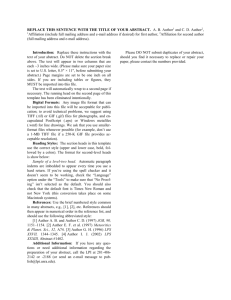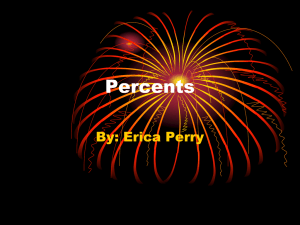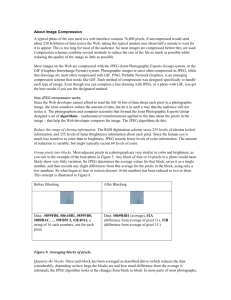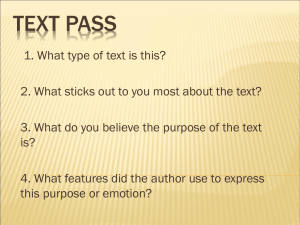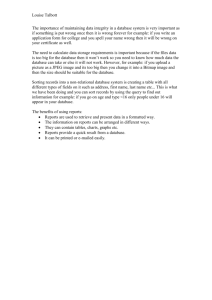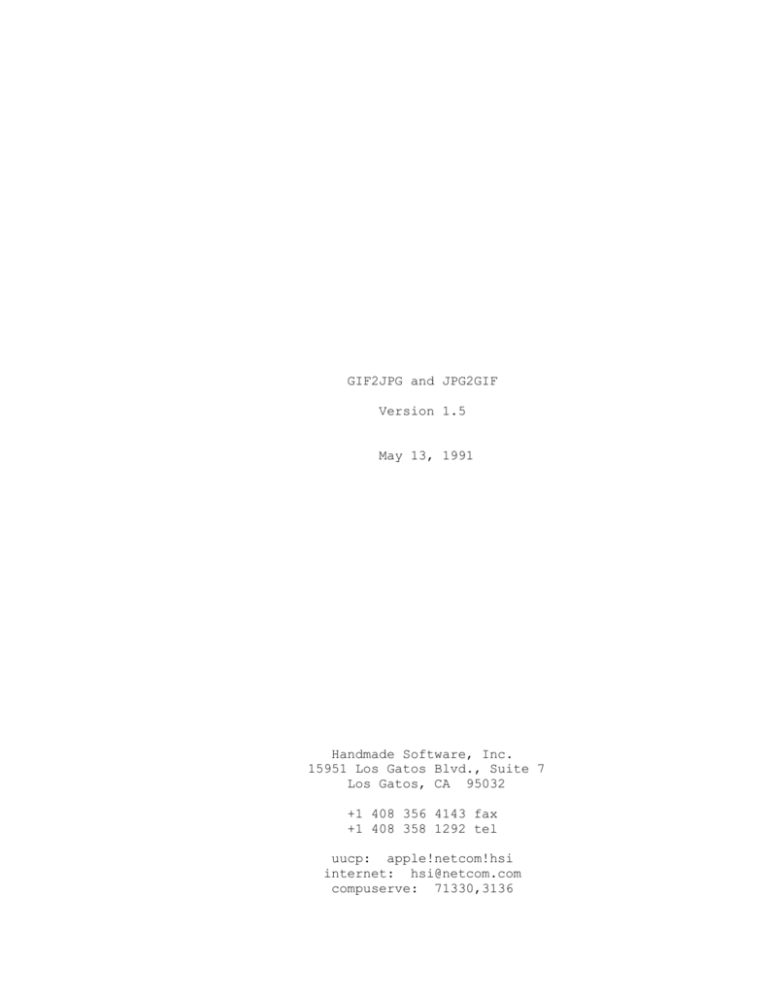
GIF2JPG and JPG2GIF
Version 1.5
May 13, 1991
Handmade Software, Inc.
15951 Los Gatos Blvd., Suite 7
Los Gatos, CA 95032
+1 408 356 4143 fax
+1 408 358 1292 tel
uucp: apple!netcom!hsi
internet: hsi@netcom.com
compuserve: 71330,3136
Copyright (c) 1990-1991
All Rights Reserved
Introduction
JPG2GIF and GIF2JPG are a set of shareware programs which
convert GIF files to JPEG files and JPEG files back to GIF
files.
Why would you want to do this?
Because typically JPEG files are several times smaller than
GIF files. So, by converting images from GIF to JPEG you save
on modeming time, long distance charges, and disk storage
requirements. The disadvantage is that you can't view JPEG
files directly; you have to convert them back to GIF files so
that you can use your favorite GIF viewer.
Using GIF2JPG & JPG2GIF
To convert .GIF files to .JPG files:
GIF2JPG [options] [files...]
If any .JPG files with the same name already exist you will be
asked whether to overwrite them. If any GIF89A files are
encountered you will be asked whether or not to convert them.
GIF89A files are not automatically converted since they can
contain text and multiple images; this information will be
lost when the image is converted to a JPEG file.
To convert .JPG files to .GIF files:
JPG2GIF [options] [files...]
If any .GIF files already exist you will be asked whether or
not to overwrite them.
There are two options which are common to both programs:
-a:
automatically proceeds (overwriting any existing
files and converting GIF89A files).
-k:
kill (removes) the original files after they are
processed.
The GIF2JPG program has two additional options:
-q[n]:
specify the JPEG quality factor which will be
used when compressing GIF files.
The default is 55.
A lower number will result in a higher
compression ratio, but a lower quality image.
Specifying a very low quality factor (less than
15) will result in poor quality images.
-j:
force compatibility with JFIF standard (also
versions of GIF2JPG v1.41 and before).
Note that you may specify wild cards as part of the file name
and that multiple file names may be specified.
Examples:
GIF2JPG
-q30 *.gif
Will convert all .GIF files in the current directory to .JPG
files, using a quality factor of 30.
JPG2GIF
-k -a
test.jpg
madonna.jpg
n?.jpg
Will convert the specified files back to .GIF files, deleting
the .JPG files and automatically overwriting the existing GIF
files.
Hardware Requirements
An IBM PC or clone (at least an 80286 for any kind of
performance).
A hard drive (JPG2GIF needs to open temporary files while
processing; you must have at least 3 times as much disk space
available as the largest image you are converting (for
example, a 640 by 480 file requires 1 Megabyte of free space].
MS-DOS or PC-DOS 3.1 or later.
380K of available RAM.
Shareware
GIF2JPG and JPG2GIF are shareware programs. Please feel free
to distribute them by giving copies to your friends, uploading
them to bulletin boards, and trading them at user clubs. You
must distribute them unaltered, and as a set, including this
document. You may not sell these files for more than a $7.00
media duplication cost.
You may use GIF2JPG and JPG2GIF on a trial basis for two
weeks; after that you must register by sending us $20 or stop
using them. The last page of this document is an order form
which you may use. When you register, you will be shipped a
copy of the latest version of JPG2GIF and GIF2JPG (if,
according to your order form, you already have the latest
version, we will ship you the first update when it is
available).
Image Quality
JPEG compression works best on images which are continuous
tone images, such as those produced by a scanner or digitizer.
Images which are drawn with paint programs typically do not
JPEG compress very well.
In addition, the best quality JPEG images result when you
start with 24 bit, undithered images. Unfortunately GIF does
not support 24 bit images; and most of the 8 bit GIF images
are dithered.
So, if you are using a scanner or digitizer to produce images,
you can get better compression ratios, and better quality
images, if you generate 24 bit Targa or TIFF files and then
convert them to JPEG files. You can't do this with GIF2JPG,
but you can with another Handmade product, Image Alchemy. See
the blatant ad below.
Answers to Frequently Asked Questions:
Q:
How do you pronounce JPG?
A:
Jay-peg. JPG is short for JPEG, which is short for Joint
Photographic Experts Group. Note that we use JPEG and
JPG to mean the same thing; JPG only exists because PC
file names are restricted to having a three letter
extension.
By the way, we firmly believe that GIF should be
pronounced with a hard G like the word gift. The primary
justification for this is that GIF stands for Graphics
Interchange Format, and the word Graphics starts with a
hard G. So if you call us up for tech. support don't be
surprised if we say GIF (with a hard G).
Q:
So what exactly is JPEG?
A:
JPEG is a lossy image file compression standard. It is
lossy because the files you get out are not quite the
same as the files you get in. JPEG compression achieves
much higher compression ratios this way. Most of the
time the changes to the image are not noticeable. The -q
option allows you to control the amount of loss (and the
compression ratios) of the images.
If you would like more information on the JPEG standard
please contact:
X3 Secretariat
Computer and Business Equipment Manufacturers Institute
311 First Street NW, Suite 500
Washington, DC 20001-2178
Q:
Are GIF2JPG .JPG files compatible with anything else?
A:
Those files which are written using the -j option are
compatible with the JPEG File Interchange Format standard
(JFIF, pronounced Jay-fif). JFIF software will be
available from a wide variety of software and hardware
vendors including Radius and C-Cube. Files written out
without the -j option are a custom format specific to
Handmade Software (though for historical reasons they
also have a .JPG extension).
Q:
Why can't I view a JPG file directly?
A:
JPEG files are always 24 bit images, which can't be
viewed directly on VGA boards. So unless you have a
Targa board or a XGA compatible IBM PS/2 you don't have
the needed hardware to view a JPG file directly (and in
fact there aren't enough of those boards currently in
circulation to justify writing a JPG view).
It is possible to convert a 24 bit image for display on
an 8 bit display, that is after all what JPG2GIF does
when it converts to a GIF file, but it is slow. Image
Alchemy, another Handmade Software product, lets you view
JPEG files directly, but it uses a uniform palette, which
produces sub-optimal image quality (the viewing mode in
Image Alchemy is intended as a preview only).
Q:
What is planned for future releases of GIF2JPG?
A:
Faster conversion time. We are currently re-coding the
software from C into 80386 assembly language. This
should allow 80386 users to decompress an image in less
than half the time it currently takes (we are only
writing 80386 code because the technique we are using
requires 1 megabyte of continuous RAM, and because of the
wonderful Intel segmented architecture, it's not really
possible to do this on anything less than a 80386).
The other major addition will be thumbnails in the JPG
files. Thumbnails are a low-resolution copy of the
original image (64 pixels by 48 pixels). Thumbnails are
useful if you want to preview an image before downloading
and/or converting it.
In the not too distant future you will able to call up a
BBS, look through a listing of JPG files, select some
number of images for previewing, and have the BBS quickly
download the thumbnails of those images. You then select
which of those images you really want and the BBS will
download them (by the way, if you are an author of BBS
software and you want your BBS to support this please
contact us).
Explanation of why GIF files grew when using
GIF2JPG v1.41 and why this doesn't happen anymore:
First a few definitions:
A continuous tone image is one where there aren't any sharp
edges between objects in the image, instead there are lots of
intermediate colours around the edges of objects. Images like
this are created when you scan a photograph or use a video
digitizer with a video camera. Another property of continuous
tone images is that there aren't any large areas which are
only one colour, instead there are many subtle different
shades of colour.
A drawn image is exactly that, an image drawn using a paint
program. Drawn images look like they are out of comic books,
they have sharp edges and large areas which are one solid
colour.
JPEG compression is an image compression technique which
compresses continuous tone images. You can JPEG compress a
drawn image, but you wouldn't want to (for reasons which are
explained below).
GIF is a compression technique which works on both continuous
tone or drawn images. GIF compression works much better on
drawn images, but most of the GIF images in the world are
continuous tone images.
So why do some images grow when going from GIF to JPEG and
back to GIF?
That has to do with the differences between continuous tone
and a drawn images.
Take for example a photograph of a dog standing in front of a
uniform blue wall. Even if the original picture looked like
the wall was one colour, when you scanned it the computer
would see subtle shadows and highlights in the wall (not to
mention the fact that scanning an image introduces sampling
noise). There also wouldn't be any instantaneous transitions
between two colours; even at the edge of the dog there would
be several pixels of anti-aliasing. You don't see these
things when looking at the photograph because you are used to
small changes in colour and detail, this is way you can tell
the difference between computer generated images and images of
real things (though with enough computing power it is now
possible to make the differences very small).
Now in contrast to scanning, think about using a paint program
to draw a picture of a dog standing in front of a blue wall.
The first step is to take a nice shade of blue and fill the
entire frame, this will be the wall. You then grab a suitable
dog colour and draw the outline of the dog. Next you use
variations of this colour and fill in the dog. When you were
finished you would have an image of a dog standing in front of
a blue wall.
You now have two different image files. A continuous tone
image of a dog against a blue wall and a drawn image of a dog
against a blue wall.
If you now take each of these files and convert them to a GIF
file, the first file will be much larger than the second file
(how much larger depends on how many different colours you
used to fill in the dog, but a factor of 3 to 4 is likely).
This difference in files sizes is caused by the compression
technique that GIF uses. GIF compression works great on areas
of solid colours and sharp transitions between colours. So
the solid blue background in the drawn image would compress
phenomenally well, as would the area where the blue touches
the dog outline colour. The only part of the scene which
wouldn't GIF compress really well is the actual dog.
If instead of converting the scanned image and the drawn image
to GIF files, you were to JPEG compress them, you would get
different results; each file would be pretty much the same
size. This is because JPEG compression was designed to
compress continuous tone images. Therefore JPEG compression
works equally well for areas that are a single colour as
for areas with subtle shading (in fact, under certain
circumstances, JPEG compression works better for areas which
are shaded than for areas which are all a single colour). So
the scanned image of the dog and the drawn images would be
pretty much the same size if JPEG compressed.
So far so good, we have shown that JPEG compression is better
than GIF compression for scanned images and it doesn't matter
for drawn images. What does this have to do with files
growing in size when they are converted from GIF to JPEG and
back to GIF?
Well, if we were to convert the JPEG file of the drawn dog to
a GIF file something interesting would happen. The solid blue
wall the dog is standing in front of would no longer be one
colour, it would consist of a large number of slightly
different shades of blue. This occurs because JPEG
compression is allowed to slightly alter the colours of
individual pixels. This is why JPEG compression ratios are so
good. Ordinarily these minor changes are not significant;
usually they are not even visible to the human eye. So the
blue wall would no longer be one identical blue colour. When
humans look at this area they don't perceive it this way; as
far as humans are concerned it is still solid blue.
Unfortunately GIF compression is not so forgiving. When you
try to GIF compression an area of image which is many
different shades of one colour, all randomly intermixed, GIF
compression does a terrible job.
We have known about this problem with JPEG compression for a
long time. In fact GIF2JPG has included code from the first
version to detect when the image being converted to a JPEG
file was a drawn image . If it was the image was left as a
GIF file.
Unfortunately there seem to be a large number of files which
are half-scanned and half-drawn. These images tend to be of
the following type (I tried to draw a dog in the right hand
side of the screen to match the previous discussion, but it's
real hard to draw with the ASCII charset):
+----------------------------------------------------------+
|
|..............**......./\.......|
| This image downloaded |.............**......./XX\......|
|
from Smiling Joe's
|............*.........\XX/......|
|
House of GIFs.
|......../\.|.|.........\/.......|
|
|......./..\|.|..........|.......|
|
|....../....\.|........./........|
|
|...../......\|........|.........|
|
Call 1-900-JOESGIF
|..../........\........|.........|
|
|...|..........|....../..........|
|
|...|..........|...O.|...........|
|
Commercial use or
|...|..........|..-+-............|
|
distribution not
|...|..........|...|.............|
|
permitted.
|...|__________|../ \............|
|
|................................|
+----------------------------------------------------------Where the left half was drawn using a paint program and only
contains two or three different colours (therefore there are
lots of areas of just one colour and lots of sharp transitions
between colours), and the right half of the image was scanned
from a photograph and therefore contains lots of different
colours (and different shades of those colours).
The problem with this image is that the left side shouldn't be
JPEG compressed. Unfortunately the previous versions of
GIF2JPG weren't very smart, they would look at the image as a
whole and, because a large portion of it was continuous tone,
decide that it was okay to JPEG compress it. Unfortunately
when the JPEG compressed file is converted back to a GIF file
the left hand side of the image will grow, making the
resultant GIF file much larger than the original GIF file.
This new version of GIF2JPG fixes this problem. It looks at
the image in a piece-by-piece manner, deciding independently
if each piece should be JPEG compressed or not. All the
pieces are then combined into one file.
JPG2GIF takes this file and converts it back to a single GIF
image.
What does all this really mean?
Assume that the original image was 640 x 480 with 256 colours.
As a GIF image it was 150k. Converting it to a JPEG file
using v1.41 or before caused it to shrink to 65k. Converting
it back to a GIF file caused the resultant file to grown to
210k.
Now using GIF2JPG v1.5 the JPEG file would still be 65k; and
when the image is converted back to a GIF the size is 150k.
So when you JPEG compress an image using this new version of
GIF2JPG you will get a file which does not grow significantly
when decompressed (the image can grow or shrink slightly, this
is due to the way that the pseudo-randomness of JPEG
compression and GIF compression inter-react).
To test this we have taken a large number of GIF files (some
sent in by users of previous versions GIF2JPG and some we had
laying around) and JPEG compressed them and then converted
them back to GIFs.
The results are that we started out with 10,456,995 bytes of
GIF files, when they were JPEG compressed they reduced to
4,969,851 bytes.
And when the images were converted back to GIF they ended up
at 9,972,594. The actual file sizes can be found in appendix
A, below. Note that some of the files grew slightly and some
shrunk slightly, but none changed an extreme amount.
One problem with this new technique of only partially JPEG
compressing an image is that the files produced are
incompatible with older versions of GIF2JPG. Therefore we
have included the -j option to generate the old style JPEG
files. Note that JPG2GIF automatically reads old .JPG files,
so any files you have already converted to JPEG do not need to
be updated (though if any are half continuous tone and half
drawn it would be a good idea to re-compress the original GIF
file).
Is JPEG compression too slow?
Recently we have gotten some complaints that JPEG compression
and decompression is too slow. We admit that it is slow, and
we are working on speeding it up; but we disagree that it is
too slow. If you are going to be sending GIF images over a
modem, it is faster to JPEG compress and decompress them, than
to send the GIF files.
To illustrate this we have done some timing benchmarks.
We took 81 GIF files at random from those that had been sent
in for various reasons and off of disks of images we had
laying around. The images were not selected because they JPEG
compressed particularly well, we just kept copying files off
of disks until we had 10 megabytes worth.
The computer used for these tests is a 20MHz 80386, with 4
Megabytes of RAM, no RAM cache, and a really slow hard drive
(an ST-225). The command line used to convert the files from
GIF to JPEG was "GIF2JPG *.gif" and the command to convert
them back was "JPG2GIF *.jpg" (we deleted the original GIF
files by hand between to two steps).
The actual number of bytes in the 81 GIF files was 10,456,995.
When the files were JPEG compressed the total file size was
4,969,851 bytes, a savings of 5,487,144 bytes.
The total time to convert the files from GIF to JPEG was just
over 40 minutes, the time spent to convert them back was just
over 1 hour and 15 minutes.
If you send the JPEG files over a 2400 baud modem you save
over 4 hours and 20 minutes, including the time needed to both
compress and decompress the files. If you were just
downloading them from a BBS, and you only had to convert them
from JPEG to GIF, the time saved is over 5 hours.
Even if you are fortunate enough to have a 9600 baud modem,
and assuming 100% modem efficiency (960 characters/second),
you still would save almost 20 minutes downloading and
decompressing the images as JPEG files as compared to
downloading GIF files.
We realize that if you have an even faster modem or a slower
computer it is possible for it to actually take more time to
transmit the JPEG file and decompress it than to transmit the
GIF files. But with a 20MHz 386 costing less than a 9600 baud
modem it doesn't make much sense for that to be the case
(unless you bought a faster modem to save on long-distance or
BBS chargers, in which case the download time becomes much
more important than the total time and it therefore makes even
more sense to JPEG compress files before transmitting them).
For those of you using a Telebit Trailblazer with an original
4.77 MHz IBM PC, we suggest you sell your modem and buy a
faster computer.
The actual details are:
Size of original GIF files:
Size of JPEG files:
Difference:
10,456,995 bytes
4,969,851 bytes
5,487,144 bytes
Total time to JPEG compress all images:
40:11 (2411 seconds)
The total time to convert all JPEG images back to GIF images:
1:16:52 (4612 seconds).
Theoretical time to transmit the GIF files (10,456,995 bytes)
at 2400 baud (240 characters/second): 12:06:11 (43,571
seconds)
Theoretical time to transmit the JPEG files (4,969,851 bytes)
at 2400 baud (240 characters/second): 5:45:08 (20,708
seconds)
Total transmission time saved:
6:21:03 (22,863 seconds)
Net difference (transmission time-compression timedecompression time): 4:24:00 (15,840 seconds)
The actual file sizes can be found in Appendix A.
Change History:
v1.5
05/13/91
Changed .JPG file format to solve problem which caused some
.GIF files to grow when being converted back from .JPG files.
Added support for reading interleaved GIFs.
The background colour of GIFs is now set to the darkest colour
in the palette.
Added -j option.
v1.41
04/24/91
Fixed bug in JPG2GIF which caused some colours to be wrong in
certain images.
v1.4
04/22/91
v1.3
04/18/91
Added -q option.
Speeded up conversion.
Changed error messages, prompts, and examples.
v1.2
03/15/91
v1.1
03/06/91
Added JFIF support.
First release.
Blatant Ad for Image Alchemy
If your interest in image files extends beyond GIF and JPEG
you might be interested in Image Alchemy.
In addition to converting between over 15 different image file
formats, including GIF, JPEG, TIFF, Targa, PCX, Sun Raster,
Silicon Graphics Image, IFF/ILBM, PBM, and Encapsulated
Postscript, Alchemy will allow you to resize images, dither
images, and view images on a VGA monitor.
See the order form below for details on how to get a shareware
version.
Bugs and Support
If you have a question or think you found a bug in GIF2JPG or
JPG2GIF don't hesitate to contact us. We prefer to be reached
by email at the addresses listed on the front page of this
manual (we apologize for not having a BBS you can call; we
will soon). You may also fax us or call us during normal
business hours (we are on the West Coast).
By the way, contact us even if you have not registered,
because in addition to wanting to know about potential bugs,
we figure the best way to encourage registrations is to
demonstrate that we care about our customers.
Trademarks
GIF2JPG, JPG2GIF, and Image Alchemy are trademarks of Handmade
Software, Inc.
All other products or services mentioned are trademarks,
registered trademarks, or service marks of their respective
companies or organizations.
Disclaimer
Handmade Software, Inc. makes no warranty of any kind, either
expressed or implied, including but not limited to implied
warranties of merchantability and fitness for a particular
purpose.
In no event shall Handmade Software, Inc. be liable for any
errors contained herein or for incidental or consequential
damages in connection with the furnishing, performance, or use
of the GIF2JPG or JPG2GIF products or documentation.
Appendix A:
Details of the test files referred to above:
(The file names have been removed to obscure the fact that the
images were all R or NC-17 rated).
Original
GIF Size
JPEG Size
Duplicate
GIF Size
228352
81929
204800
195850
78099
133658
170774
42298
228992
16681
15780
18762
134760
166047
199651
131758
32772
32910
105220
115222
54272
875472
237568
62673
34816
272964
127710
160501
125952
150586
61641
97197
32768
144706
13109
29409
261120
264448
66905
128199
81929
113507
86071
31053
47816
71769
24735
93782
16681
15780
18762
77648
76972
75207
52555
20666
18426
37663
40980
28727
290903
66576
19247
17642
135371
45023
80655
34676
58252
61641
97197
17498
45095
13109
15100
81807
99122
23209
248055
81929
225832
195203
88188
72605
183633
51734
208251
16681
15780
18762
140563
178659
194445
137821
38948
54964
106165
111282
63358
892499
196817
61502
25287
286302
134910
177491
56130
159437
61641
97197
36573
166127
13109
31675
241612
265028
64457
149632
79718
84716
27409
148588
80401
113664
20480
101439
106657
78758
17134
18288
14630
187264
45566
107284
99620
18150
281858
223734
114733
63328
180395
269755
206593
200215
171903
28544
268629
53248
79872
63488
51200
503890
152935
126206
33792
113115
60829
91885
49333
35840
288316
66747
110196
33992
14847
98575
106657
32079
17134
18288
14630
86234
45566
107284
99620
18150
100893
65099
114733
63328
180395
85543
84623
85709
61121
26261
119638
15785
24247
19721
36165
166076
51132
50525
33792
48050
60829
56562
49152
35840
58595
66747
43058
64730
22415
147590
106657
75053
17134
18288
14630
175588
45566
107284
99620
18150
286064
191855
114733
63328
180395
223617
208314
203982
168577
33445
318371
31031
43045
34855
62308
279601
84908
126728
33792
101624
60829
97789
54835
35840
205519
66747
118116
10456995
4969851
9972594
If you would like copies of the actual images to verify these
results just send us enough blank, formatted disks, to hold 10
megabytes (i.e. nine 1.2 meg disks, eight 1.4 meg disks,
twenty-nine 360k disks, or fifteen 720k disks), and a selfaddressed, stamped box. We will also need a signed note
stating that you are over 18 and want to receive adult images
(yes, the test images were almost all R or NC-17 rated).
JPG2GIF and GIF2JPG 1.5 Order Form
Send to:
Qty
Total
Handmade Software, Inc.
15951 Los Gatos Blvd., Suite 7
Los Gatos, CA 95032
Description
Price
_____ JPG2GIF & GIF2JPG for IBM PC
__________
$20.00
_____ Image Alchemy -- Shareware version
__________
$2.00
Sub-Total:
__________
California Residents add applicable sales tax
__________
Total
__________
Circle Disk size:
Circle Payment form:
3 1/2"
Check
5 1/4"
MC
Card #:______________________________________
____________
Visa
Amex
Exp. Date:
Signature: _____________________________________________________
Name: ___________________________________________________________
Address: ________________________________________________________
________________________________________________________
City: ___________________________ State: _________ Zip: _________
Phone: (______) ________________
Fax: (______) ________________
Phone number of BBS you got this program from: __________________
Name of BBS: ____________________________________________________



